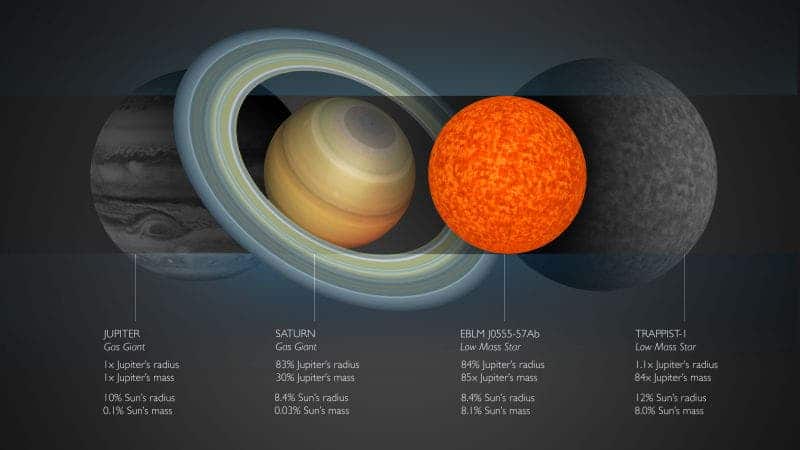Astronomers at the University of Cambridge have spotted the smallest star we’ve ever come across. It’s barely bigger than Saturn and even smaller than Jupiter.
The newly-found star called EBLM J0555-57Ab is part of a binary system located some 600 light-years away. It was identified using the now common transit technique, the same that helped us find thousands of other exoplanets. Very briefly, the transit method involves measuring the dipping brightness levels as a cosmic body transits in front of its parent star. If the dimming star follows a period pattern, then we have an orbiting object on our hands. Usually, this orbiting body is a planet but in this case, it was a star and people could hardly believe just what kind of star this is.
Despite it’s just about the smallest star physics allows, EBLM J0555-57Ab is also one the densest active stellar objects. While Jupiter has a gravitational pull equivalent to 2.5 times of Earth, this tiny star has a gravity some 300 times strong than of our planet. The smallest theoretical mass for a star is between 0.07 to 0.08 solar masses and EBLM J0555-57Ab just nails it slightly above the limit with 0.081 solar masses. We might find an even smaller active star but given the rarity, it ought to take a while.
“Our discovery reveals how small stars can be,” said Alexander Boetticher, the lead author of the study, and a Master’s student at Cambridge’s Cavendish Laboratory and Institute of Astronomy. “Had this star formed with only a slightly lower mass, the fusion reaction of hydrogen in its core could not be sustained, and the star would instead have transformed into a brown dwarf.”
The star is likely colder than many of the gas giant exoplanets that have so far been identified. Stars in the same class as EBLM J0555-57Ab are considered prime hunting ground for finding Earth-like alien planets. For instance, the greatly hyped Trappist-1 system is comprised of a white dwarf that’s about 2,000 times dimmer than the Sun but also seven Earth-like planets, three of which are supposed to be in the habitable zone — not too cold, not too hot, but just right for liquid water to plausibly form on the rocky surface of these alien worlds. The newly-measured star has a mass comparable to the current estimate for TRAPPIST-1, but has a radius nearly 30% smaller. Details about it will be published in the peer-reviewed journal Astronomy & Astrophysics (for now you can find it in preprint).










